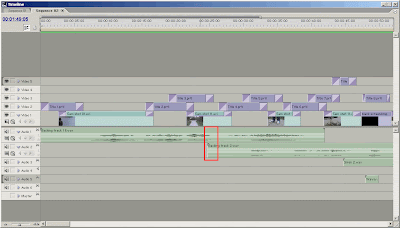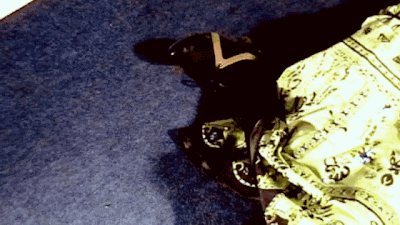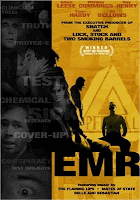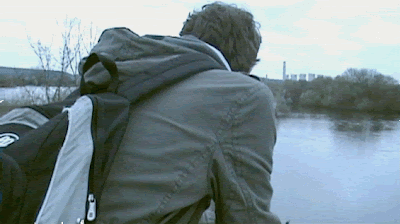This is our final opening sequence. Please view our DVD version as the DVD version is in wide screen and gives better perpesctive.
Tuesday, 28 April 2009
Monday, 27 April 2009
Evaluation
In what ways does your media product use, develop or challenge forms and conventions of real media products?
A typical convention of a thriller is the use of an eerie backing track. Luke and I not only used this convention, but also developed it. We used two suspenseful backing tracks. The first was relatively quiet, and calm, and the second was louder and more forceful. The first track slowly fades into the second and hence builds suspense (as shown in the print screen below).

The non-diegetic sounds we used are also a development of this typical convention. Because they are not specific and not directly linked to the footage, they create suspense and engage the audience.
We also aimed to create a sense of isolation. To do this we filmed the protagonist walking down narrow pathways. We also had several shots of the boy walking down long pathways off into the distance, this suggests he doesn't really know where he is going, and gives the impression of being lost and having little purpose. The sense of isolation and desperation are typical convention and I feel we not only used but also developed these conventions.
Most thrillers conventionally use a creepy font for their titles to attract attention. I feel we have developed this convention as our font could suggest life draining away. As well as this, most thrillers have their titles fading in slowly. We also use this convention.
Overall, I feel Luke and I not only used typical conventions of a thriller but also developed them, and as a result made an engaging opening sequence to a thriller.
How does your media product represent particular social groups?
In our opening sequence our aim was to represent vulnerable teenagers. To do this we used a variety of long shots when filming. The long shots are used to establish the character. The boy looks small and isolated in comparison to the large open surroundings which suggests the boy is insignificant. We also filmed the boy from behind. This gives the connotations that he is walking away from something. During the opening sequence we avoid showing the boy’s face. The aim of this is to create suspense for the audience and to emphasise his isolation from society. As the sequence progresses we do however include a single shot showing the boy’s face, this is so the audience can identify with the protagonist.
In the soundtrack the news reporter says “A boy has been reported missing in Attenborough” this suggests that the boy seen walking is the missing child.
The smashed vase heard, suggests an argument which in turn suggests the boy has run away from home. These non-diegetic sounds further emphasise the boy's vulnerablity and his need to escape from his surroundings. Again this suggests the boy’s isolation.
During the editing process, we used the cross-dissolve effect to show the ellipsis of time. An example of this is when the boy walks down the alley way. The ellipsis of time helps to show that the boy is lonely for long lengths of time and emphasises his isolation.

The boy’s costume is dull and not very colourful; again this shows his separation from society. His shoes however are fashionable, this reminds the audience he is a youthful teenager. The bag is used to show he is leaving somewhere which again shows the boy’s isolation. The pathetic fallacy of the grey dull weather is reflective of the boy’s state of mind. In contrast the shots of the woman are brightly coloured despite the woman being dead/injured. This further emphasises the boy’s split from society.

What kind of media institution might distribute your media product and why?
 As our opening sequence is potentially quite unnerving, the type of institution to distribute our product would not be a family orientated organisation, because young children would be alarmed by the nature of the thriller. A film distribution company would distribute our film into cinemas. A suitable example would be Dogwoof Pictures. Dogwoof Pictures is a UK film distributor who is probably best known for the release of EMR (James Erskine, Danny McCullough 2004). EMR was the first film worldwide to have a simultaneous release.
As our opening sequence is potentially quite unnerving, the type of institution to distribute our product would not be a family orientated organisation, because young children would be alarmed by the nature of the thriller. A film distribution company would distribute our film into cinemas. A suitable example would be Dogwoof Pictures. Dogwoof Pictures is a UK film distributor who is probably best known for the release of EMR (James Erskine, Danny McCullough 2004). EMR was the first film worldwide to have a simultaneous release.EMR (James Erskine, Danny McCullough 2004) is a physiological thriller distributed by Dogwoof Pictures. It made both critical and fininacial success. Dogwoof Pictures have experience in distributing British Thrillers and so would be suitable for distributing our product.
Who would be the audience for your media product?
Our target audience was primarily 14 - 24 year olds both male and female.

We targeted this audience as research shows 35% of people who watch thrillers are of this age. We wanted our protagonist to be of this age, as then our target audience can relate to some of the things he is feeling, and thereby engage the audience.
However, despite aiming our thriller at a younger audience, the nature of our thriller can appeal to a wide age-range of people and is suitable for anyone who enjoys thrillers.
How did you attract / engage your audience?
In our opening sequence, Luke and I tried to create suspense. We didn't want to give away too much of the story in our first two minutes so instead tried to engage the audience by creating narrative enigmas. We believed that an interesting way to engage the audience was through the use of sound. So in our soundtrack we included various sounds that didn't specifically fit with the footage of the boy walking. Examples of these are the police sirens, the police radio, the news reporter, and the argument. These things are not seen, but merely heard, (non-diegetic sounds). The sounds are also not too specific; we don't reveal too much of what will happen. The aim of this to engage the audience and get them asking questions, such as: "Why are there police sirens?"
To create suspense, when filming, we didn't want to show too much of the protagonist's face, instead we used over the shoulder shots, and long shots.

With not showing the audience the boy's face, it keeps the audience interested. They are not sure who he is and how he may be involved in the story. The quick straight cuts of the woman's body also engage the audience. They do not understand how she is involved in the story. Again we also avoid showing her face; this further enhances the feel of mystery. The creation of suspense and mystery engages the audience further as they want to find out what has happened and so continue to watch.
The protagonist in our opening sequence is fairly young. We wanted a young boy because the character is meant to be vulnerable. As well as this it also engages our young target audience as they can easily identify with the boy and his emotions.
From audience feedback I can tell that we successfully engaged our audience during the opening sequence. Examples of feedback were;
"I was engaged by the opening sequence, I wanted to know how the story unravelled, to see whether the boy walking was the victim or the perpetrator."
"The opening sequence did engage me, the way the events did not seem to happen in a chronological order added mystery to the sequence and made me want to see more."
"The opening sequence was suspenseful and mysterious and did engage me. The fact that the boy leaves the bag on the bench intrigues me, I want to find out whether it is significant or not. The background (non-diegetic) sounds also interest me as I want to find out how they fit in with the story."
What have you learnt about technologies from the process of constructing this product?
Both Luke and I have learnt many things whilst filming and editing our opening sequence. Most importantly I have learnt the importance of using a tri-pod and the importance of setting the white balance. I am also now far more confident with using a digital video camera and can quite comfortably operate one again.
During the editing sequence, the major thing I have learnt is how to use the editing suite, Adobe Premier Pro. For example one problem we encountered was that we wanted our opening sequence to be set at night, however when we tried to film at night, the footage was really dark and of a low quality. Instead we filmed during the day and using Adobe Premier Pro we could adjust the light levels to our preference.

To do this, we added the levels effect, and then we could easily adjust each aspect of colour in our footage. We altered several levels which enhanced our footage, the main alteration was the (RGB) Gamma level increased to give us clearer footage.
As well as learning how to adjust the effects on the footage, I have also learnt how to cut the footage down using various methods.
 Examples are setting the in and outpoints, and then dropping it to the time-line or alternatively, using the razor tool to cut the footage where desired. I have a full understanding of using the time-line, I understand the importance of rendering footage (gives the footage a higher quality finish and smoothness) and am confident with most aspects of using Adobe Premier Pro. I am also confident I can quickly learn how to use various other editing programmes as I now understand the foundations of editing footage. I have also revisited Audacity. I used this programme to edit the soundtracks we used and am now confident in using it.
Examples are setting the in and outpoints, and then dropping it to the time-line or alternatively, using the razor tool to cut the footage where desired. I have a full understanding of using the time-line, I understand the importance of rendering footage (gives the footage a higher quality finish and smoothness) and am confident with most aspects of using Adobe Premier Pro. I am also confident I can quickly learn how to use various other editing programmes as I now understand the foundations of editing footage. I have also revisited Audacity. I used this programme to edit the soundtracks we used and am now confident in using it.Finally I learnt how to export and burn our film onto a DVD as we had to do this for draft film which we handed to our teacher for marking.
Looking back at your preliminary task, what do you feel you have learnt in the progression from it to the full product?
Since my preliminary task, I feel I have learnt many new skills, not only just with using a camera and editing software, but also in the planning and research stages. In my preliminary task, little thought went into planning, and very little research was done. However in the Thriller project, I did thorough research into both the industry and into what people wanted to see. This meant we could specifically target our audience.
 Both Luke and I also carefully studied the conventions of a thriller, this set us in good stead, as we knew what we wanted to include in our thriller and what we wanted to achieve. We also planned very carefully in our final project; not only did we make brainstorms and a storyboard, but we also made a time-line of each shot, which we could easily re-order. I think these two stages helped a great deal and were responsible for a high quality opening sequence I feel we produced.
Both Luke and I also carefully studied the conventions of a thriller, this set us in good stead, as we knew what we wanted to include in our thriller and what we wanted to achieve. We also planned very carefully in our final project; not only did we make brainstorms and a storyboard, but we also made a time-line of each shot, which we could easily re-order. I think these two stages helped a great deal and were responsible for a high quality opening sequence I feel we produced.I have also progressed with physically using a camera. Since the preliminary task I have learnt how to pan properly. To film a high quality pan you must pan a whole 180 degree pan, and then in the editing stage crop the footage so you have a pan of your desired length. This way you eliminated a jerky movement. I also now understand the importance of continuity. Previously when filming the preliminary task, we had the curtains closed, and then open. Although we did not film the curtains, it meant the lighting was dramatically different.
To hide this we had to make the film black and white. This meant, however, I was far more cautious when filming the thriller project, and I was always looking out for places where we may have made a continuity error.
Compared to when we edited the preliminary task, I am now much more confident with my editing skills. I know a whole array of short-cuts and am much more comfortable with editing. Both Luke and I edited the footage, and we worked well as a team as we could both see ways of improving our footage. One main alteration we made from our draft edit was changing our aspect ratio from 4:3 to widescreen. We felt this made our opening sequence look more cinematic and professional. We also made sure to set the white balance so the colours were the same in each shot.
When making the preliminary task, we had very limited time, this meant the quality of our filming was poor and the editing was rushed. The lack of time also meant that we didn't have time to review our project and make suitable alterations. However during the thriller project, we had far more time, this meant I could assess our progress and we discussed what needed to be altered. This meant we were always improving our opening sequence.
Overall, I feel as I have progressed since the preliminary task. I now have a far greater understanding of using editing software, a camera, and how to create suspense. Luke and I have worked well together, we have listened to each other and between us, and I feel we have created a high quality opening sequence to a thriller.
Friday, 3 April 2009
Progress III
The program we are using to edit our footage is Adobe Premier Pro. Intially we captured our footage and then imported it into our "projects tab". To keep our editing progress organized, we sorted our clips into different bins.
 We also made two seperate sequences. One sequence has our initial draft footage, and the other sequence has our new footage.
We also made two seperate sequences. One sequence has our initial draft footage, and the other sequence has our new footage.
To start editing the footage, we dragged a clip into the "input monitor" from the "project tab". Here we can set the in and out points, to select the desired footage, and then drop it to the time-lime using the insert tool. With doing this, we only have to work with the relevant footage.
Here we can set the in and out points, to select the desired footage, and then drop it to the time-lime using the insert tool. With doing this, we only have to work with the relevant footage.
 We also made two seperate sequences. One sequence has our initial draft footage, and the other sequence has our new footage.
We also made two seperate sequences. One sequence has our initial draft footage, and the other sequence has our new footage.To start editing the footage, we dragged a clip into the "input monitor" from the "project tab".
 Here we can set the in and out points, to select the desired footage, and then drop it to the time-lime using the insert tool. With doing this, we only have to work with the relevant footage.
Here we can set the in and out points, to select the desired footage, and then drop it to the time-lime using the insert tool. With doing this, we only have to work with the relevant footage.
We can then edit the footage using tools tab and the effects tools in the project tab. Use the zoom-in and out function located in the bottom left to easily select your footage. Then click and drag the effect onto the footage.
Thursday, 2 April 2009
Creating the soundtrack
To make our soundtrack, we combined a mixture of royalty free sounds and recorded voice tracks. We edited the sounds and put them together using audacity. We got our royalty free sounds from:
http://www.soundsnap.com/
http://incompetech.com/m/c/royalty-free/
Here are screen shots of the process we went through when creating our soundtrack:


http://www.soundsnap.com/
http://incompetech.com/m/c/royalty-free/
Here are screen shots of the process we went through when creating our soundtrack:


Progress II
After recieving feedback from our initial film, we have decided to re-shoot our entire footage. The reason for doing this, is some of the shots are badly filmed, however if we re-shoot singular shots, the lighting may be different.
We are also going to use a new actor. Scott Green, our initial actor, is also taking AS Media, and subsequently filming his own thriller. This means he has little time to act in our film. Instead, Sam Bartys will act for us. He is a reliable, available friend, who has experience in drama.
Although we would have prefered our thriller to be set at night, it was not possible for us to film it at night as we do not have sufficient equipment. Instead we tried to adjust the saturation, exposure and various levels of colour in the editing stage, to make our footage darker. However when we burnt our initial draft edit onto disc, the quality of the image dropped greatly. As a result we will re-shoot in daylight, despite our preferences.

We are also going to use a new actor. Scott Green, our initial actor, is also taking AS Media, and subsequently filming his own thriller. This means he has little time to act in our film. Instead, Sam Bartys will act for us. He is a reliable, available friend, who has experience in drama.
Although we would have prefered our thriller to be set at night, it was not possible for us to film it at night as we do not have sufficient equipment. Instead we tried to adjust the saturation, exposure and various levels of colour in the editing stage, to make our footage darker. However when we burnt our initial draft edit onto disc, the quality of the image dropped greatly. As a result we will re-shoot in daylight, despite our preferences.
Subscribe to:
Comments (Atom)

